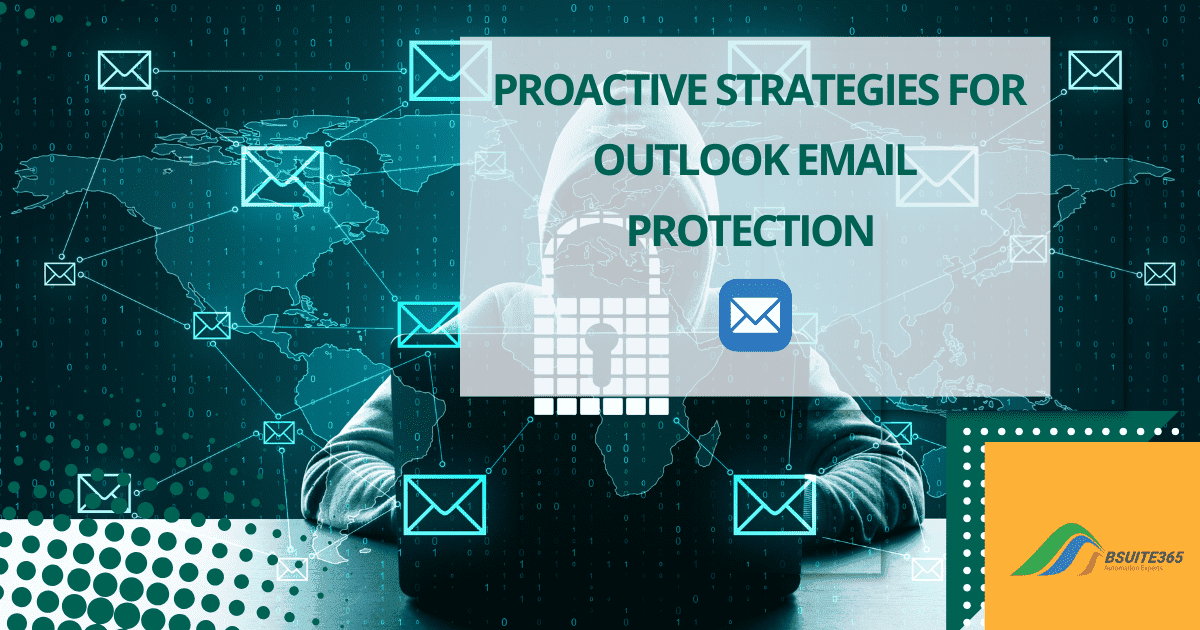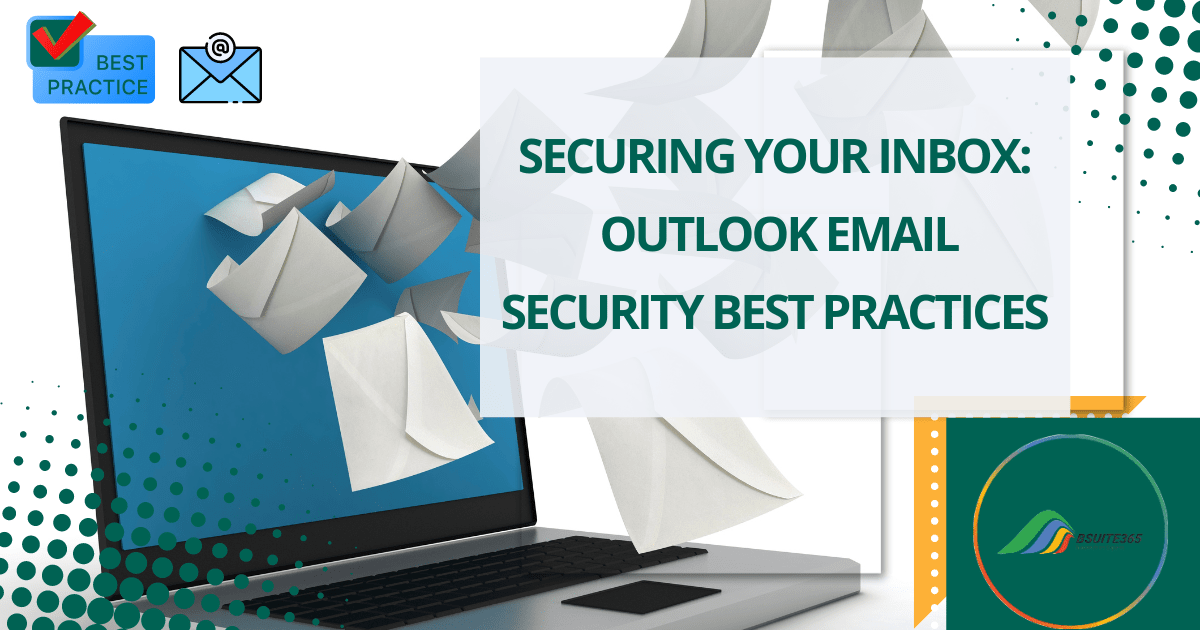Outlook Email Security Training for Safer Communication
Email has become an indispensable tool for businesses and facilitates communication and collaboration. However, it also serves as an entrance for a wide range of cyber-attacks. Organizations face a variety of email threats, including phishing, spear phishing, malware, and social engineering.
So, with the increased number of cyberattacks, it is critical to engage in thorough training and awareness initiatives in addition to implementing top-notch email security solutions. Employees, being the primary users of email, play a critical role in protecting their organizations from such threats. Employee awareness can considerably lower the likelihood of security breaches.
Recognizing the potential dangers is essential for establishing effective security measures. This leads to several important questions: What are some effective methods for training staff in email security best practices? How can organizations conduct simulated phishing attacks to test their defenses? And more.
This blog post will delve into these questions and offer practical guidance on fostering a culture of email security, effectively training employees, and conducting simulated phishing attacks to strengthen your organization’s defenses.
Overview of Common Email Threats Facing Organizations
To effectively prevent cyber attacks, it is critical to understand email threats and how they can deceive users. For example, phishing attacks impersonate legitimate companies to trick clients into revealing sensitive information.
Here are some common email threats that organizations face:
- Phishing: Deceiving recipients into clicking on malicious links or opening attachments.
- Spear Phishing: Targeted attacks that mimic legitimate emails from known individuals or organizations.
- Malware: Malicious software that can infect systems and steal data.
- Business Email Compromise (BEC): Fraudulent emails impersonating executives or vendors to trick employees into making unauthorized payments.
Effective training and awareness programs can help employees:
- Recognize and avoid phishing attempts.
- Handle attachments and links cautiously.
- Report suspicious activities promptly.
- Follow best practices for email security.
By investing in employee training and awareness, organizations can strengthen their defenses against email-based threats and protect their valuable assets. also Understanding the threats is the first step, but implementing proactive security measures is just as crucial. Learn more about Proactive Strategies for Outlook Email Protection to safeguard your organization against these risks
Building a Culture of Email Security Awareness in Your Organization
A strong culture of email security awareness within an organization is a powerful defense against email attacks. By developing a security-conscious mindset among employees, you can significantly reduce the risk of falling victim to phishing scams, malware, and other malicious threats. Here’s how:
1. Establishing Email Security as a Core Value
Setting email security as a core value creates a mindset in which people prioritize security and recognize its significance. In other words, when security is given the highest priority, employees are more likely to actively contribute to the organization’s security.
A. Integrating Security Awareness into Company Culture
Make email security an important goal and include it in your organization’s security culture.
This may involve the following steps:
- Provide Ongoing Training: Educate staff about security best practices, such as email security, password management, and social engineering awareness.
- Run Regular Campaigns: Use campaigns to reinforce security messages.
- Maintain Vigilance: Encourage staff to be aware of and report any security threats.
B. Leadership’s Role in Promoting Security Practices
Leadership plays an important role in encouraging security practices and cultivating a security-conscious culture inside a business. Leaders must demonstrate that they care about security and set a positive example for employees to follow. When leaders prioritize security, it motivates everyone else to do the same.
Here are some ways leaders can promote security:
- Set a Good Example: Senior executives should lead by example and actively promote email security practices. Lead by example by consistently following security best practices.
- Encourage Participation: Leaders should demonstrate a commitment to security and encourage employees to follow best practices by actively participating in security training and awareness programs.
- Allocate Resources: Ensure that adequate resources are allocated to support security initiatives within the organization.
- Hold Accountable: Set clear expectations for security compliance and hold employees accountable for their actions in relation to security practices.
- Empower Employees: Encourage employees to report security concerns and recognize their contributions to promoting security within the organization.
- Recognize and Reward Security-Conscious Behavior: Acknowledge and reward employees who demonstrate exemplary security practices. This can help to reinforce positive behaviors and encourage others to follow suit.
2. Developing Clear Email Security Policies
One way to stop email attacks is by creating an explicit email security policy. These standards give employees a defined framework to work within and specify permissible email usage, data management practices, and security measures.
A. Guidelines for Safe Email Usage and Communication
Create clear guidelines for email usage and communication, especially when dealing with sensitive information and attachments. These guidelines should cover topics such as avoiding phishing scams, handling attachments cautiously, and protecting sensitive information.
Here are some specific guidelines for safe email usage and communication:
- Avoid Phishing: Be cautious of unsolicited emails, especially those with urgent requests or suspicious links.
- Verify Attachments: Scan attachments for malware before opening them.
- Use Strong Passwords: Create complex passwords for your email account and avoid sharing them with others.
- Be Wary of Attachments: Avoid opening attachments from unknown or suspicious senders.
- Avoid Public Wi-Fi: Use caution when accessing your email on public Wi-Fi networks.
B. Policies on Handling Sensitive Information and Attachments
Clear policies can help reduce human error by giving specific instructions and guidelines for handling sensitive information and attachments. Establish policies that detail how to manage sensitive information and attachments securely.
Ensure that these policies are easily accessible and regularly updated. Make it clear to staff that by following these guidelines, they can reduce the risk of email-related security breaches and protect the organization’s sensitive information. Here are some key points to emphasize:
- Encryption: Always encrypt sensitive information before sending it via email.
- Data Classification: Implement a data classification system to identify and protect sensitive information.
- Access Controls: Restrict access to sensitive information to authorized individuals only.
- Attachment Management: Establish guidelines for handling attachments, including setting file size limits and prohibiting certain file types.
- Data Loss Prevention (DLP): Implement DLP measures to prevent unauthorized data transfer.
3. Regular Communication and Reinforcement
A robust email security culture requires constant reinforcement and communication. You can keep security top of mind and make sure staff members are prepared to tackle new risks by giving them regular updates and reminders.
By implementing regular communication and reinforcement strategies, you can create a culture where employees are actively engaged in protecting your organization from email-based threats. Here are key strategies for effective communication:
- Consistent Messaging: Reinforce the importance of email security through regular reminders and updates.
- Multiple Channels: Utilize a variety of communication channels, such as newsletters, posters, and internal communications, to reach all employees.
- Tailored Content: Customize your messaging to address specific concerns or threats relevant to your organization.
- Interactive Engagement: Encourage employees to ask questions, provide feedback, and participate in security-related activities.
- Positive Reinforcement: Recognize and reward employees who demonstrate exemplary security practices.
Create an environment where employees feel empowered to report suspicious activities. Establish clear reporting procedures and make it easy for employees to raise concerns. Here are examples:
- Security Newsletters: Distribute regular newsletters that highlight recent security incidents, best practices, and tips.
- Visual Reminders: Post security-related posters or screensavers in common areas.
- Internal Announcements: Use internal communication platforms to share important security updates and announcements.
- Training Sessions: Conduct regular training sessions to provide in-depth information on email security topics.
- Security Challenges: Organize security-related challenges or competitions to encourage employee engagement.
4. Employee Empowerment
Empowering employees to play an active role in email security is crucial for building a strong and effective culture. When employees feel invested and responsible, they are more likely to be vigilant and proactive in identifying and preventing threats.
To empower employees, consider the following strategies:
- Provide clear guidelines: Ensure that employees have clear guidelines on how to identify and report suspicious emails.
- Create a safe environment: Foster a culture where employees feel comfortable reporting security concerns without fear of reprisal.
- Offer training and support: Provide ongoing training and support to help employees stay updated on the latest threats and best practices.
- Recognize and reward: Acknowledge and reward employees who contribute to security efforts.
- Encourage participation: Involve employees in security initiatives and decision-making processes.
By empowering employees, you can create a more engaged and effective security culture, ultimately reducing the risk of email-based attacks.
5. Continuous Improvement
Sustaining a robust security posture requires ongoing improvement. You can make sure that your company stays safe by routinely reviewing your email security program and making adjustments for unexpected challenges.
Key strategies for continuous improvement:
- Regular Assessments:
- Security Audits: Conduct regular security audits to identify vulnerabilities and areas for improvement.
- Employee Surveys: Gather feedback from employees to assess the effectiveness of your security awareness program.
- Threat Intelligence: Stay informed about emerging threats and trends in the email security landscape.
- Technology Updates: Keep your security tools and software up-to-date with the latest patches and updates.
- Adaptability: Be prepared to adapt your security measures as threats and technology evolve.
- Feedback Loops: Encourage employees to provide feedback on security initiatives and address their concerns promptly.
By prioritizing continuous improvement, you can ensure that your organization remains ahead of the curve and is well-equipped to address new email security challenges.
How to Train Employees on Identifying Phishing Emails in Outlook
Phishing attacks are a common threat to organizations, and employees often find themselves on the front lines of defense. By training employees to recognize and avoid phishing emails, you can significantly reduce your organization’s risk of falling victim to these attacks.
Here is how:
1. Understanding the Anatomy of a Phishing Email
Phishing emails are designed to trick recipients into clicking on malicious links or opening harmful attachments. Educate employees on the common characteristics and red flags of phishing emails.
By understanding the common characteristics of phishing emails, you can better identify and avoid these threats. Here are the key characteristics of phishing emails:
- Urgency or Threat: Phishing emails often create a sense of urgency or threat to pressure recipients into taking immediate action.
- Suspicious Links or Attachments: Be cautious of unexpected links or attachments, especially those that seem unrelated to the email’s content.
- Grammatical Errors and Typos: Phishing emails may contain grammatical errors or typos that are indicative of a scam.
- Impersonation: Phishers often impersonate legitimate individuals or organizations to gain trust.
- Inconsistencies: Look for inconsistencies in the sender’s email address, domain name, or message content.
- Unusual Requests: Be wary of unusual requests, such as asking for personal information or requesting payments.
Always be cautious and verify the legitimacy of any suspicious emails before clicking on links or opening attachments. Here are examples of phishing tactics:
- Fake invoices or bills: Phishers may send fraudulent invoices or bills to trick recipients into making unauthorized payments.
- Password reset requests: Phishers may send emails pretending to be from a legitimate organization, asking for your password or other personal information.
- Job offers or promotions: Phishing emails may offer fake job opportunities or promotions to entice recipients to click on malicious links.
2. Practical Training Methods
Practical training methods are critical for providing staff with the skills and information required to recognize and avoid phishing emails. These strategies assist employees build critical thinking abilities and apply their knowledge to real-world circumstances by giving hands-on experience and scenarios.
To effectively train employees on identifying phishing emails, consider the following practical methods:
A. Hands-On Workshops and Interactive Training Sessions
Conduct hands-on workshops and interactive training sessions to engage employees actively. These sessions can include:
- Simulated Phishing Attacks: Conduct simulated phishing attacks to test employees’ ability to recognize and respond to threats.
- Real-World Examples: Share real-life examples of phishing emails to illustrate common tactics and red flags.
- Role-Playing Exercises: Have employees practice identifying phishing emails in role-playing scenarios.
- Online Modules and Gamification: Utilize interactive training modules and gamification elements to make learning more engaging.
- Case Studies: Analyze real-world phishing incidents to understand common patterns and techniques.
B. Utilizing Outlook’s Built-In Features to Identify Suspicious Emails
Outlook offers several built-in features that can help employees identify suspicious emails. Here are some key features to teach employees:
- Junk Folder: Teach employees how to use Outlook’s Junk folder to filter out suspicious emails.
- Safe Senders List: Show employees how to create a Safe Senders list to allow emails from trusted contacts.
- Block Senders: Demonstrate how to block specific senders or domains to prevent phishing emails from reaching your inbox.
- Email Headers: Teach employees how to examine email headers for suspicious information like sender addresses, IP addresses, and dates.
- Spam Filters: Explain how to customize Outlook’s spam filters and report junk emails to improve accuracy.
By combining these practical training methods, you can equip employees with the skills and knowledge needed to identify and avoid phishing threats.
3. Creating Customized Phishing Detection Guidelines
Customized instructions provide employees with a systematic method for reviewing emails for potential phishing threats. They give personnel the ability to recognize and respond to phishing attacks successfully.
A. Developing Easy-to-Follow Checklists for Employees
Create simple checklists that employees can use to evaluate email security. These checklists should help staff recognize and report phishing emails and cover key areas such as:
- Sender Information:
- Is the sender’s email address both legitimate and expected?
- Does the domain name match the sender’s claimed organization?
- Subject Line:
- Does the subject line contain urgent or threatening language?
- Is the subject line unexpected or out of context?
- Content:
- Are there any suspicious links or attachments?
- Does the email request personal information or payments?
- Are there any grammatical errors or typos?
- Sender Behavior:
- Does the sender create a sense of urgency or pressure?
- Is the sender trying to elicit a quick response?
- Formatting and Grammar:
- Are there any inconsistencies in formatting or style?
- Are there any grammatical errors or typos?
B. Role-playing Scenarios to Practice Spotting Phishing Attempts
To help employees apply their knowledge in real-world situations, incorporate role-playing scenarios into your training sessions. These scenarios can simulate various phishing attempts, such as:
- Fake invoice phishing: Present employees with a fake invoice email and ask them to identify the red flags.
- Password reset phishing: Simulate a phishing email requesting a password reset and have employees evaluate its legitimacy.
- Job offer phishing: Present a fake job offer email and ask employees to spot the suspicious elements.
- Urgent request phishing: Create a scenario where employees receive an urgent email requesting immediate action and ask them to assess the risks.
By providing employees with these tools and resources, you can equip them effectively to identify and respond to phishing threats.
4. Utilizing Technology to Support Training
In addition to training and awareness, technology can play a significant role in helping employees identify and prevent phishing attacks. There are a variety of tools and software available that can assist employees in recognizing phishing emails, including:
- Anti-phishing solutions: These solutions utilize machine learning and behavior analysis to effectively detect and block phishing emails before they reach employees’ inboxes.
- Email security plugins: Plugins can be installed in Outlook to provide additional layers of protection, such as spam filtering, malware scanning, and phishing detection.
- Phishing simulation tools: These tools can be used to conduct simulated phishing attacks and test employees’ awareness.
Integration of Anti-Phishing Tools with Outlook
Integrating anti-phishing tools with Outlook can significantly enhance your organization’s email security. These tools can:
- Identify and block phishing emails: Anti-phishing tools can use advanced techniques to detect and block phishing emails before they reach employees’ inboxes.
- Provide real-time alerts: Some tools can provide real-time alerts to warn employees about suspicious emails.
- Generate reports: Anti-phishing tools can generate reports that provide insights into phishing attempts and help you identify trends.
By utilizing technology to support your training and awareness efforts, you can create a more robust and effective email security program.
Conducting Simulated Phishing Attacks to Improve Email Security
To improve email security, run simulated phishing attacks in a controlled environment. This helps to assess employees’ ability to recognize and respond to phishing threats. Some advantages of simulated phishing exercises are:
- Test Employee Awareness: Assess your employees’ ability to recognize and respond to phishing threats.
- Identify Vulnerabilities: Discover potential weaknesses in your organization’s security measures.
- Measure Training Effectiveness: Evaluate the impact of your training programs on employee awareness.
- Continuous Improvement: Use the results of simulations to refine your training programs and security measures.
Designing Effective Phishing Simulations
To ensure that simulations are effective, it’s essential to create phishing emails that closely resemble those sent by actual attackers. This includes using realistic subject lines, sender addresses, and content that mimics genuine communication.
Some common examples include:
- Fake Invoice Phishing:
- Scenario: Your employee receives an email that appears to be from a legitimate vendor or supplier, requesting payment for an invoice.
- Red Flags: The invoice may contain errors or inconsistencies, incorrect payment details, or suspicious links or attachments.
- Password Reset Phishing:
- Scenario: Employees receive an email claiming to be from a popular online service, asking you to reset your password due to a security breach.
- Red Flags: The email may contain grammatical errors or typos, the link to reset your password may lead to a fraudulent website, or the email may request sensitive personal information.
The effectiveness of phishing simulations can be enhanced by customizing them to specific departments and roles within the organization. For example, a simulation targeting the IT department might focus on technical threats, while one aimed at the HR department might involve social engineering tactics.
Analyzing and Reporting Results
By tracking the number of employees who fall victim to phishing attacks during simulations, organizations can assess the effectiveness of their training programs and security measures.
Analyzing simulation results can help identify areas where employees need additional training or support. This information can be used to develop targeted training programs and implement corrective actions to improve overall security.
You can use the results to identify areas where your security measures may be lacking.
Continuous Improvement and Follow-Up
As phishing tactics evolve, it’s important to update simulations to ensure they remain relevant and effective. This includes incorporating new phishing techniques and trends into the simulations.
The insights gained from phishing simulations can be used to improve ongoing training programs. By identifying areas where employees need additional guidance, organizations can develop more effective training materials and delivery methods.
To enhance your email security efforts, consider partnering with BSuite365 for expert consulting services. Our team can help you design and conduct effective simulated phishing attacks, analyze results, and provide tailored recommendations for improving your organization’s email security posture.
Contact us today to learn more about how BSuite365 can help you strengthen your defenses against phishing threats.
Conclusion
Training and awareness programs are vital in preventing email breaches. Research shows that well-trained employees are better equipped to recognize and respond to threats, thereby reducing the likelihood of successful attacks. Regular updates and continuous education are key to maintaining a strong security posture.
A security-aware workforce significantly enhances organizational safety. By fostering a culture of vigilance and providing effective training, you can protect your organization from email-based threats.
Building and maintaining email security awareness requires commitment and effort. Implementing comprehensive training programs and fostering a culture of security will help safeguard your organization against evolving threats.
Ready to take action? Bsuite365 offers comprehensive training programs tailored to your organization’s specific needs. Our expert trainers will equip your employees with the skills and knowledge to identify and mitigate email-based risks.
Don’t wait until it’s too late. Contact Bsuite365 today to learn more about our training solutions and how we can help you safeguard your organization.
FAQs
Q1. Why is Organizational Email Security important?
Email is one of the most common attack vectors. A strong email security culture can significantly reduce your organization’s risk.
Q3. What are the key elements of organizational email security?
- Strong password policies
- Multi-factor authentication (MFA)
- Regular security updates
- Phishing awareness training
Q4. How can you build a security awareness culture?
- Top-down commitment: Leadership must prioritize security.
- Employee engagement: Foster a culture where employees feel empowered to report suspicious activity.
- Regular communication: Keep employees informed about emerging threats and best practices.
Q5. What are the best practices for maintaining email security?
- Be cautious of attachments and links.
- Verify sender addresses.
- Avoid clicking on suspicious links.
- Use strong, unique passwords.
- Keep software updated.
Q6. What tools and technologies can help maintain email security?
- Email filtering
- Data loss prevention (DLP)
- Security information and event management (SIEM)
Q7. What are the key topics to cover in email threat awareness training?
- Phishing attacks (e.g., spear phishing, whaling)
- Malware (e.g., viruses, ransomware)
- Social engineering tactics
- Business email compromise (BEC)
Q8. How to Build Email Security Awareness?
- Here are effective training methods for building security awareness:
- Interactive workshops
- Phishing simulations
- Gamification
- For training tailored to specific needs and roles:
- Consider the specific needs and roles of your employees.
Q9. What are additional tips for protecting your email?
- Use a secure email provider.
- Enable two-factor authentication.
- Be cautious of public Wi-Fi networks.
- Regularly review security policies.
Our experts will be glad to help you, If this article didn’t answer your questions. ASK NOW
We believe this content can enhance our services. Yet, it’s awaiting comprehensive review. Your suggestions for improvement are invaluable. Kindly report any issue or suggestion using the “Report an issue” button below. We value your input.



